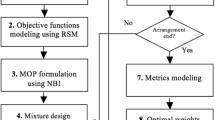Abstract
Simultaneous optimization of multiple-quality characteristics and determining the process settings is a critical and difficult task for practitioners. Such types of problems are generally referred to as “multiple-response optimization” problems. To handle high-dimensional multiple-response problems, a popular strategy, using desirability functions, is recommended by various researchers. Various types of desirability index functions are recommended to convert multiple scale-free desirability measures to a single composite desirability (or single objective) value. Thus, the objective is then to maximize the single composite desirability for a specific problem. In this paper, a new adaptive penalty function-based “maximin” desirability index is proposed, which provide superior solution as compared to existing maximin approach, for close (or tight) engineering tolerances of response characteristics. The superiority was proved based on statistical comparison using varied case situations and different swarm intelligent search strategies.
Similar content being viewed by others
References
Harrington EC (1965) The desirability function. Ind Qual Control 21(10):494–498
Derringer G, Suich R (1980) Simultaneous optimization of several response variables. J Qual Technol 12(4):214–219
Catillo ED, Montgomery DC, McCarville D (1996) Modified desirability functions for multi response optimization. J Qual Technol 28(3):337–345
Kim K, Lin D (2000) Simultaneous optimization of mechanical properties of steel by maximizing exponential desirability functions. J R Stat Soc C Appl Stat 49(3):311–325
Khuri AI, Conlon M (1981) Simultaneous optimization of multiple responses represented by polynomial regression functions. Technometrics 23(4):363–375
Pignatiello J (1993) Strategies for robust multiresponse quality engineering. IIE Trans 25:5–11
Vining GG (1998) Compromise approach to multiresponse optimization. J Qual Technol 30(4):309–313
Ko Y-H, Kim K-J, Jun C-H (2005) A new loss function-based method for multiresponse optimization. J Qual Technol 37(1):50–59
Su C-T, Tong L-I (1997) Multi-response robust design by principal component analysis. Total Qual Manag 8(6):409–416
Antony J (2001) Simultaneous optimization of multiple quality characteristics in manufacturing processes using Taguchi’s quality loss function. Int J Adv Manuf Technol 17:134–13
Liao HC (2006) Multi-response optimization using weighted principal component. Int J Adv Manuf Technol 27:720–725
Tong L-I, Wang C-H (2002) Multi-response optimization using principal component analysis and grey relational analysis. Int J Adv Manuf Technol 9:343–350
Tong L-I, Wang C-H, Chen H-C (2005) Optimization of multiple responses using principal component analysis and technique for order preference by similarity to ideal solution. Int J Adv Manuf Technol 27:407–414
Chiao C-H, Hamada M (2001) Analyzing experiments with correlated multiple responses. J Qual Technol 33(4):451–465
Peterson JJ (2004) A posterior predictive approach to multiple response surface optimization. J Qual Technol 36(2):139–153
Gen M, Cheng R (1996) A survey of penalty techniques in genetic algorithms. IEEE proceedings of Evolutionary Computation, Nagoya Japan, 804–809
Mukherjee I (2007) Modelling and Optimization of Abrasive Metal Cutting Processes, Ph.D. Thesis, Indian Institute of Technology, Kharagpur, India
Kumar DN, Reddy MJ (2006) Ant colony optimization for multi-purpose reservoir operation. Water Res Manag 20:879–898
Dorigo M (1992) Optimization, Learning and Natural Algorithms (in Italian). Ph.D. thesis, ipartimento di Elettronica, Politecnico di Milano, Italy
Bilchev G, Parmee IC (1995) The Ant Colony Metaphor for Searching Continuous Design Spaces. LNCS Springer-Verlag Berlin Heidelberg 993:25–39
Wodrich M, Bilchev G (1997) Cooperative distributed search: the ant’s way. Control Cybernatics 26(3):413–446
Mathur M, Karale SB, Priye S, Jyaraman VK, Kulkarni BD (2000) Ant colony approach to continuous function optimization. Ind Engg Chem Res 39:3814–3822
Socha K, Dorigo M (2008) Ant colony optimization for continuous domains. Eur J Oper Res 185:1155–1173
Kennedy J, Eberhart RC (1995) Particle swarm optimization. Proc IEEE Int Conf Neural Netw 4:1942–1948
Bratton D, Kennedy J (2007) Defining a Standard for Particle Swarm Optimization. Proc. of IEEE Int. Conf. on Swarm Intelligence Symposium (SIS 2007) 120–127
Harper D, Kosbe M and Peyton L (1987) Optimization of Ford Taurus wheel cover balance (by Design of experiments—Taguchi’s Method). Fifth Symposium on Taguchi Methods ASI 527–539
Acknowledgment
The authors would like to acknowledge the Department of Science and Technology, India, for funding this ongoing research work.
Author information
Authors and Affiliations
Corresponding author
Rights and permissions
About this article
Cite this article
Bera, S., Mukherjee, I. An adaptive penalty function-based maximin desirability index for close tolerance multiple-response optimization problems. Int J Adv Manuf Technol 61, 379–390 (2012). https://doi.org/10.1007/s00170-011-3704-9
Received:
Accepted:
Published:
Issue Date:
DOI: https://doi.org/10.1007/s00170-011-3704-9




